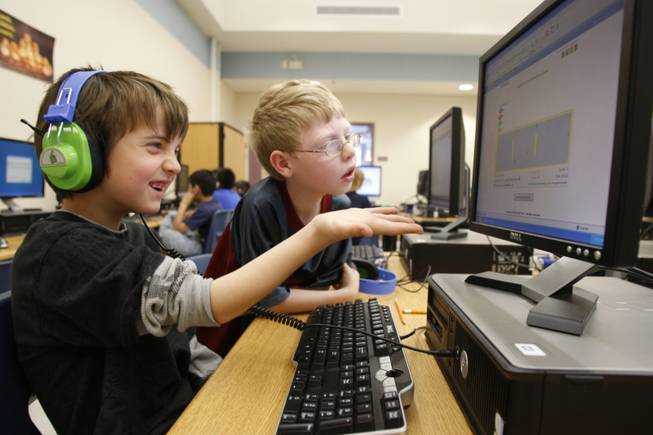
Steve Marcus / FILE
Math games have the attention of second graders Cameron Bryant, left, and Brandon Laxton in May at the new Robert Taylor Elementary School in Henderson.
Friday, July 24, 2009 | 2 a.m.
Sun Coverage
Beyond the Sun
For the first time time since the No Child Left Behind law took effect in 2002, Robert Taylor Elementary School’s academic gains were enough to meet federal requirements.
Principal Janet Dobry couldn’t be prouder of the school’s teachers, staff and students, but she knows better than to promise a repeat performance.
In 2010 the state will raise the proficiency bar for students in all grades, with increases of 12 percentage points in elementary reading and writing. Under next year’s stricter requirements, Taylor’s most recent test results wouldn’t make the grade.
After two years of adequate progress, the district as a whole fell short this time. But there were standout examples such as Taylor, where nearly 80 percent of the students are minorities and more than two-thirds qualify for free or reduced-price meals.
This year 54.6 percent of Taylor’s students met or exceeded the proficiency standard in reading and writing, up from 27 percent in 2004. And 59 percent of the students this year met or exceeded the proficiency standard for math, up from 39 percent in 2004.
Dobry attributed the improvements to several factors — help from a support team provided by the Nevada Education Department, a renewed focus on using test data to identify and help remedial students, and setting aside 45 minutes a day for reading.
The school also benefitted from moving into a brand-new building in Henderson equipped with the latest classroom technology, including interactive display boards and voice amplifiers for the teachers.
“Everything is so fresh and bright,” Dobry said. “For most of our kids, this is nicer than anywhere else they’ve ever gotten to go to school.”
•••
The Clark County School District’s experiment in single-sex education is being watched with interest by a number of researchers, including University of Nevada, Reno, associate professor Margaret Ferrara.
Clark County’s single-sex education program is based on the premise that brain development of boys and girls differs to such a degree that they need to be taught in different ways in classroom settings tailored to their needs.
Ferrara, who teaches in the College of Education, is working with Clark County teachers and administrators on research tools that will help them track student progress. She has also developed a questionnaire to help teachers determine whether they are best suited to leading boys-only or girls-only classrooms.
For the 2008-09 academic year, there were 14 Clark County campuses offering single-sex classrooms. At some schools the separate classes were offered only in one or two subjects, such as reading and mathematics. At two elementary schools — Diaz and Cortez — the program is under way campuswide.
•••
The Clark County School District’s recommended summer reading list for high school students is arguably a downer — a boy soldier’s memoir of mass slaughter in the Sierra Leone; a Chinese girl’s tale of suffering in the extreme poverty of her rural village; two books about eating disorders.
The nonfiction list includes “A Long Way Gone: Memoirs of a Boy Soldier,” and “The Diary of Ma Yan: The Struggles and Hopes of a Chinese School Girl.” Also on the list are “Inside Out: Portrait of an Eating Disorder,” which details the author’s battle with bulimia, and “Thin,” a documentarian’s photo essays of young women at an inpatient clinic in Florida.
Of the list’s six books, one, “Blue Lipstick — Concrete Poems,” is upbeat, although it’s not really nonfiction. It follows the adventures of a 15-year-old girl through text and graphics.
The books were selected to represent a broad range of genres and topics, said Diane Reitz, the district’s literacy director. All of the titles received positive reviews from the American Library Association and most have also been recommended specifically for high school students by School Library Journal, she said.
Though the topics on the district’s nonfiction list might be considered heavy reading, “those are the kinds of books kids are interested in,” Cassandra Barnett, president of the American Association of School Librarians, told the Sun. “They want to read about real issues that are happening in the world, and they are very curious about how the young characters respond to the situations.”

Join the Discussion:
Check this out for a full explanation of our conversion to the LiveFyre commenting system and instructions on how to sign up for an account.
Full comments policy